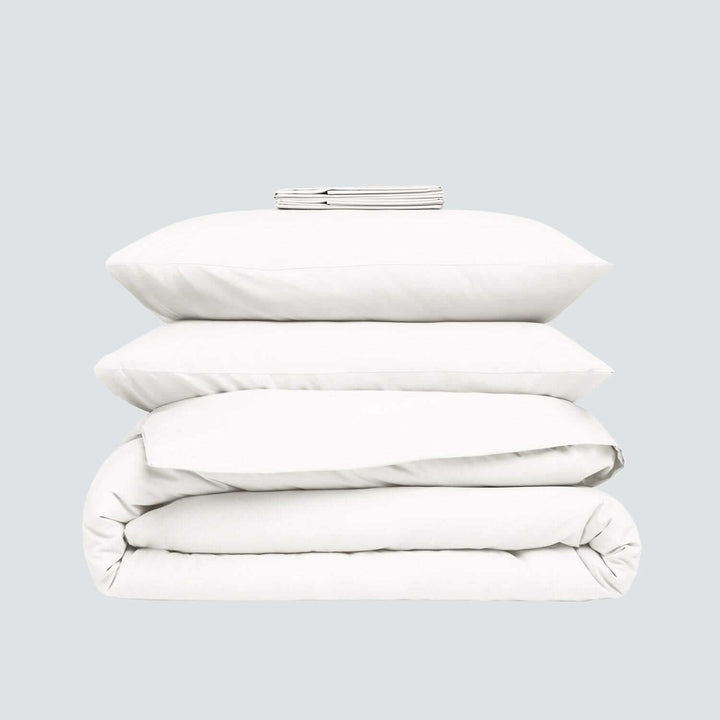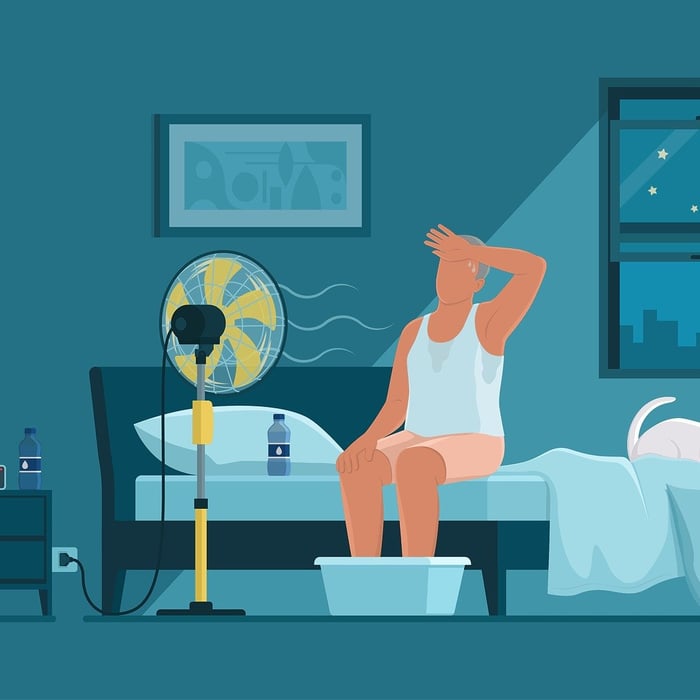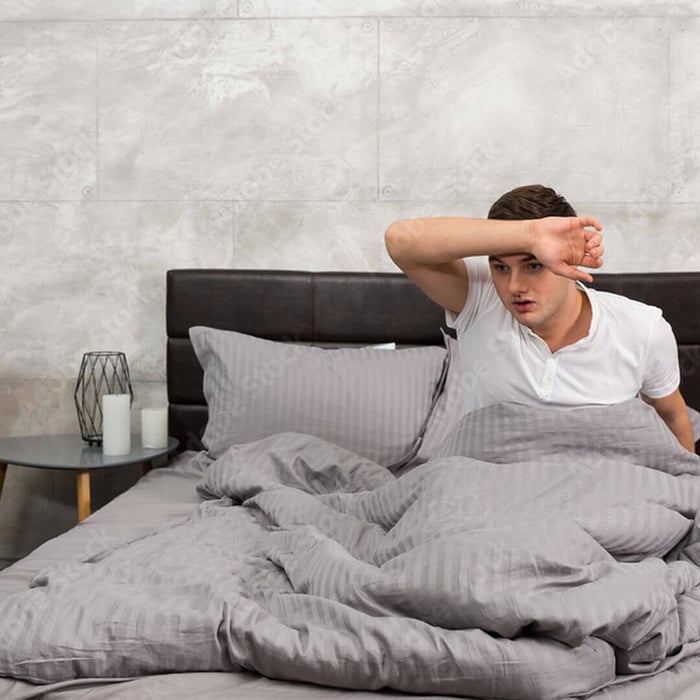Table of Contents
- If you sometimes wake up sweaty, you’re not alone — and you’re not imagining things.
- Why You Wake Up Sweaty (The Simple Explanation)
- Humidity: The Hidden Reason You Wake Up Damp (Even in a Cool Room)
- The Role of Bedding Materials (Your Biggest Source of Heat Traps)
- 10 Common Reasons People Wake Up Damp or Overheated (And What They Mean)
- How to Reduce Nighttime Dampness (Simple, Science-Backed Fixes)
- Why Regenerative Wool Helps You Stay Drier at Night
- A Simple Checklist to Stay More Comfortable at Night
- Bring it all together
- Key Takeaways (Quick Summary)
- FAQs on Wool Duvet Inserts, Comforters & Sustainable Bedding
If you sometimes wake up sweaty, you’re not alone — and you’re not imagining things.
Many people go to bed feeling perfectly comfortable, only to wake up sweaty and damp, clammy, or even drenched. Some wake up sticky, some wake up cold and damp, others wake up in a room that doesn’t even feel hot.
The good news?
Most causes are simple, environmental, and fixable.
Let’s break down why you wake up sweaty — and how to stay cooler and drier with better humidity control, better airflow, and more breathable bedding.
Why You Wake Up Sweaty (The Simple Explanation)
Your body gives off heat and moisture every night. If that heat and humidity can’t escape your bedding, it builds up around your skin. When moisture becomes trapped, you eventually wake up sweaty and damp — even if your room is cool.
Most people assume this is “night sweats.”
Often? It’s just physics + bedding.
The biggest triggers:
trapped humidity
synthetic fabrics
foam mattresses
too many layers
poor airflow
normal temperature cycles
hormonal shifts
illness or recovery
But the #1 culprit for why you wake up sweaty is almost always your sleeping environment, especially when your bedding can’t breathe.
Organic Wool Comforter | Made in New Zealand, Breathable All-Season Comfort

$342.00
$380.00
Sleep naturally better with our organic wool comforter Unlike down or synthetic comforters that trap heat, our spun wool design wicks away moisture and prevents overheating, so you stay cool & dry. Designed for deeper sleep with a gentle weight… Read more
Humidity: The Hidden Reason You Wake Up Damp (Even in a Cool Room)
Humidity is one of the most overlooked causes of waking up sweaty — especially if you live in a warm climate or have the AC running at night.
Humidity traps moisture
When the air is humid, sweat can’t evaporate properly. Instead, it collects on your skin or inside your bedding.
That’s why people report:
feeling clammy in a cold room
waking up damp despite fans or AC
sweating in an air-conditioned bedroom
feeling wet and chilled at dawn
Why you feel sweaty AND cold
This happens when your body overheats first, then cools too quickly under fabric that stays damp.
Your skin ends up chilled, sticky, and uncomfortable — a classic “cold sweat.”
The Role of Bedding Materials (Your Biggest Source of Heat Traps)
Most people blame their thermostat. But in the majority of cases, it’s actually the materials sitting closest to your skin.
Synthetic bedding traps heat and humidity
Microfiber, polyester, bamboo blends, and “cooling” synthetics hold moisture like a sponge and release it slowly. The result?
You feel warm, then suddenly damp, then cold.
These materials often cause:
sweating in air conditioning
waking up sticky
damp sheets
sweaty chest or hairline
Regenerative Organic Cotton Sheet Set – Soft, Breathable & Sustainable

$189.00
Softer Sheets. Cleaner Sleep. Our organic cotton sheet set are simply better for the earth, and for your sleep. Grown on low-impact regenerative farms that actively heal the soil, our cotton is then woven and finished responsibly. This process eliminates… Read more
Natural fibers breathe — especially wool
Nature created fibers like wool, linen, and organic cotton with built-in permeability.
Wool, especially, is engineered by nature to move heat and humidity away from your body. Its natural crimp structure creates tiny air channels that act like ventilation — helping you stay balanced through temperature swings.
This is where Antipodean Home stands out:
Our regenerative New Zealand wool doesn’t fight your body — it works with it. Airflow, ventilation, moisture transfer… it’s all built into the fiber itself.
This is why wool comforters consistently outperform synthetics and down for hot sleepers.
10 Common Reasons People Wake Up Damp or Overheated (And What They Mean)
If you’re waking up damp or overheated, it’s often your body responding to everyday factors. These are the most common reasons it happens and the clues they can give you.
1. Hormone cycles
Natural fluctuations in both men and women can trigger heat spikes — including perimenopause, pregnancy, postpartum recovery, and cycle shifts.
2. Stress or cortisol pulses
A 2am or 3am “heat burst” is often stress-related, not environmental.
3. Illness or immune response
You may sweat at night with flu recovery, a mild fever, or during the healing process.
4. Sleeping in a warm, insulated bed
Heavy quilts, foam mattresses, and thick comforters trap heat — even in winter.
5. Eating late or drinking alcohol
Digestion and alcohol both raise core temperature.
6. Medications
Common triggers include antidepressants, nicotine withdrawal, and beta blockers.
7. High humidity bedrooms
Even if it feels “cool,” humidity prevents sweat from evaporating.
8. Synthetic pajamas or sheets
If your clothing traps moisture, your bedding can’t compensate.
9. Over-layering
Too many blankets → trapped humidity → sticky nights.
10. Air conditioning paradox
Cold air + non-breathable bedding often creates the highest moisture buildup.
How to Reduce Nighttime Dampness (Simple, Science-Backed Fixes)
Your body already knows how to regulate temperature — it just needs bedding and a room environment that supports it. These easy tweaks help reduce humidity, improve airflow, and create a naturally calmer sleep climate.
1. Focus on breathability first
Breathable bedding matters more than room temperature.
2. Swap synthetics for natural fibers
Wool, organic cotton, and linen allow heat and moisture to escape rather than accumulate.
3. Reduce humidity in your bedroom
Use a fan, crack a window, or use a dehumidifier in sticky climates.
4. Layer lightly
One breathable comforter is more effective than stacking sheets and blankets.
5. Choose the right comforter fill
Wool excels for hot sleepers because it regulates temperature and humidity simultaneously.
Sustainable & Regenerative Bedding Bundle | No More Night Sweats, Just Deeper Sleep

$598.40
$748.00
Cooler Nights & Deeper Sleep — Every Night Elevate your sleep with the only sustainable bundle crafted from regenerative New Zealand wool and organic cotton for true all-season comfort. These breathable, eco-friendly fibers naturally wick away heat and moisture to… Read more
Why Regenerative Wool Helps You Stay Drier at Night
Regenerative wool from Aotearoa New Zealand isn’t just sustainable — it performs exceptionally well for temperature regulation:
Air channels formed by natural crimp improve airflow
Moisture vapor transfer moves humidity away before it becomes sweat
Balanced insulation keeps you warm without overheating
Natural fibers breathe far better than synthetics
ZQRX-certified wool supports land restoration and animal welfare
Our spun wool Airlay design elevates this further:
Wool is spun into tiny airy clusters, allowing heat to rise, humidity to disperse, and your sleep environment to stay naturally balanced.
This is the same design that makes our organic wool comforter ideal for hot sleepers, sweaty sleepers, and those with inconsistent temperature cycles.
A Simple Checklist to Stay More Comfortable at Night
Choose a breathable natural comforter
Avoid microfiber or polyester sheets
Reduce humidity before bed
Keep the room between 65–68°F
Wear natural-fiber sleepwear
Layer lightly instead of heavily
Avoid heavy meals or alcohol late at night
Use organic cotton sheets or wool bedding for air circulation
Organic Wool Duvet Insert & Bedding Set | Sustainable & Regenerative | Made in New Zealand

$475.15
$559.00
Cooler Nights & Deeper Sleep — All Year Long Looking for the perfect organic wool duvet insert and wool bedding set? This complete bundle includes both the duvet insert and cover. (The insert uses the same breathable, temperature-regulating design as… Read more
Bring it all together
Waking up damp, clammy, or overheated isn’t always a sign that something is wrong — most of the time, it’s simply your bedding and your environment working against your body’s natural temperature rhythm. When heat and humidity get trapped, even a cool room can leave you feeling sticky by morning.
The key is choosing materials that actually let your body breathe. When airflow, moisture transfer, and natural fibers work together, your sleep becomes calmer, drier, and far more consistent.
Key Takeaways (Quick Summary)
Most “why do I wake up sweaty?” moments come from humidity and trapped heat, not just room temperature.
Synthetic bedding holds onto moisture, making you feel damp even with AC.
Natural fibers, especially regenerative New Zealand wool, help move heat and moisture away from your body.
Small changes — like reducing humidity, layering lightly, and switching to breathable bedding — make a noticeable difference fast.
A more balanced sleep climate supports deeper rest, steadier temperature, and fewer sweaty wakeups.
If you’re ready to create a sleep environment that finally works with your body, not against it, explore naturally breathable bedding made from regenerative New Zealand wool and organic cotton. A small shift toward nature-led materials can make a big difference in how dry, calm, and comfortable your nights feel.
At Antipodean Home, we design bedding that helps you sleep with nature, not fight against it — using fibers that breathe, regulate, and restore the way nature intended.
Explore Our Bedding For Hot Sleepers Collection
FAQs on Wool Duvet Inserts, Comforters & Sustainable Bedding
Why do I wake up sweaty even when the room is cool?
Because humidity and trapped heat matter more than room temperature. If your bedding can’t release moisture, you can still overheat and wake up damp in a cool room.
Why do I wake up sweaty but cold?
You likely overheated first, then cooled down quickly as moisture stayed trapped in your sheets. That sudden shift creates the “cold sweat” feeling.
Why do I wake up sweating in the middle of the night?
Your core temperature naturally rises between 2–4am. If your bedding holds heat or humidity, you’re more likely to overheat during this window.
Can bedding materials really cause nighttime sweating?
Absolutely. Synthetic and microfiber fabrics trap heat and moisture, while natural fibers like wool and organic cotton let them escape.
Why do I wake up damp when the AC is running?
Air conditioning cools the air but doesn’t solve humidity trapped inside your bedding. If moisture can’t evaporate, you’ll still feel sticky or clammy.
Why do women seem to wake up sweaty more often?
Cycle phases, perimenopause, pregnancy, and postpartum changes can all affect temperature regulation, making women more sensitive to heat at night.
Does humidity really affect how I sleep?
Yes. High humidity prevents sweat from evaporating, meaning moisture stays on your skin or inside your bedding instead of venting out.
Why do I get sweaty nights only sometimes?
Factors like stress spikes, late-night meals, alcohol, hormonal shifts, or even different sleepwear can cause inconsistency from night to night.
What bedding is best for people who overheat?
Breathable natural fibers — especially wool — are the most effective because they regulate both heat and humidity, unlike synthetics or heavy cotton.
How do I stop waking up sweaty?
Reduce humidity, lighten your layers, improve airflow, and switch to breathable bedding that supports heat and moisture transfer. These small steps make the biggest difference.




